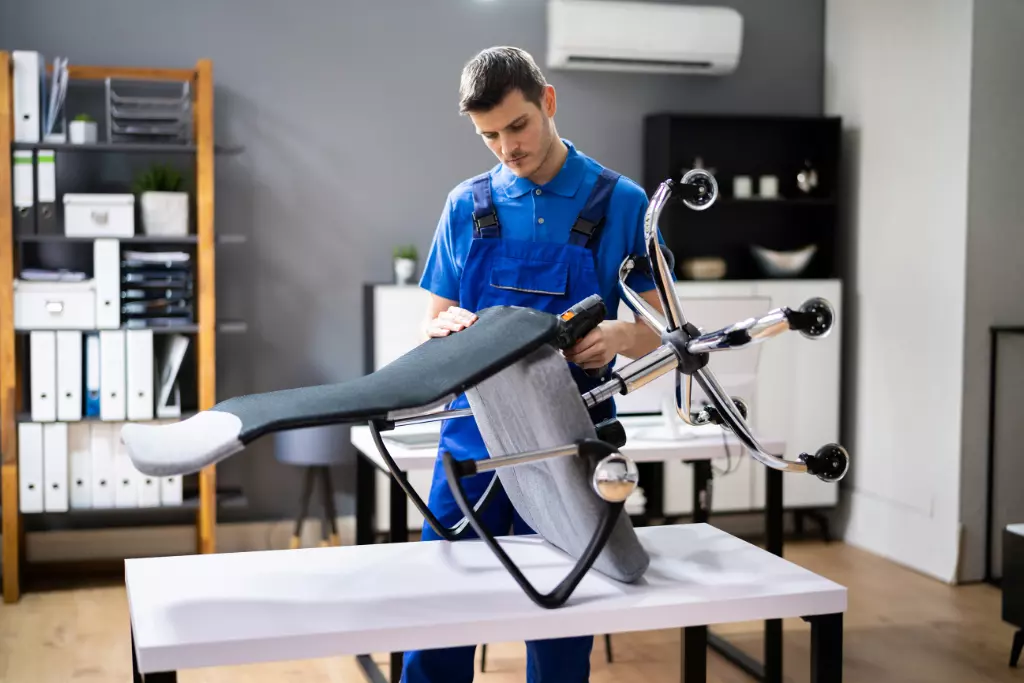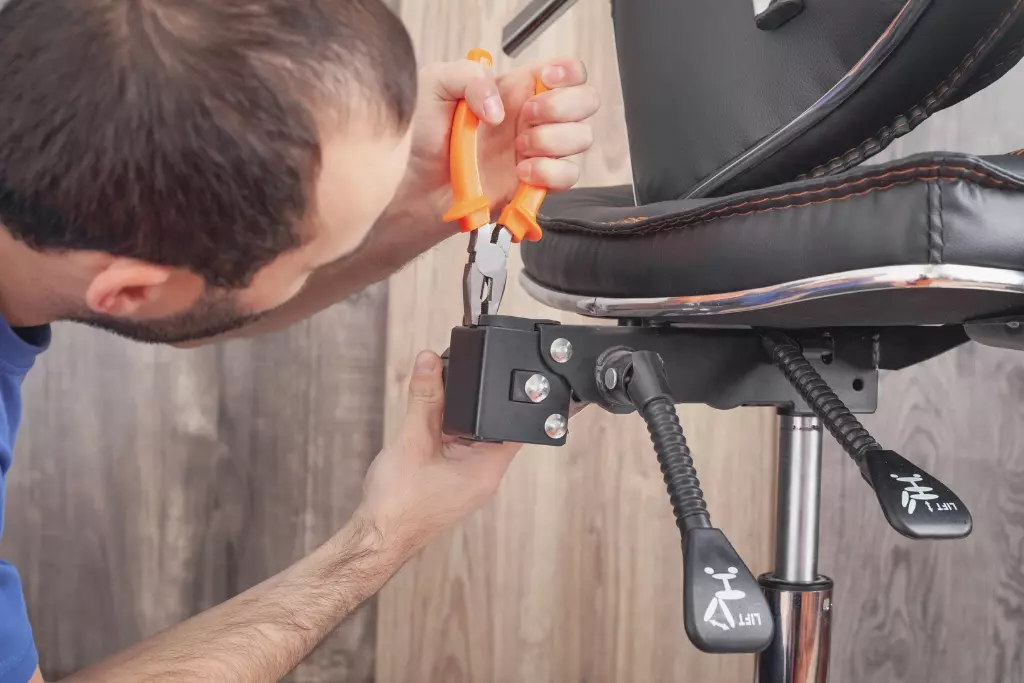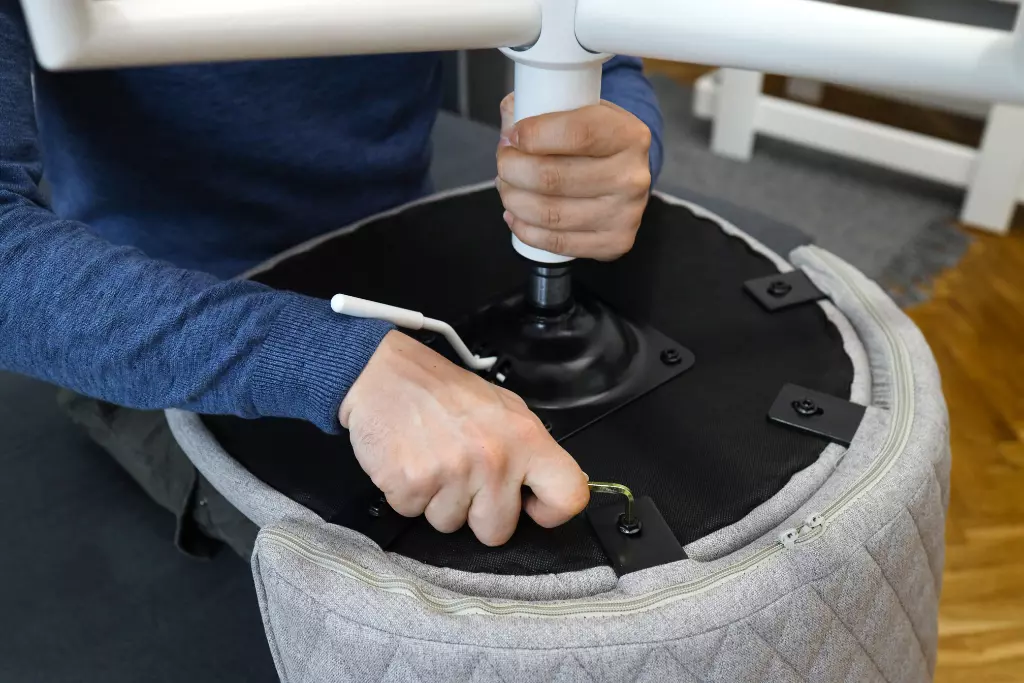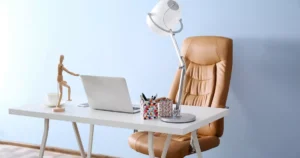Has your office chair started leaning back whenever you sit in it, no matter how hard you try to keep it up right? I know how frustrating it can be to constantly fight your chair for proper posture when you’re just trying to get some work done. A leaning chair can really detract from productivity and cause unwanted stress and strain on your back. But don’t lose hope; a leaning chair can frequently be repaired rather than replaced.
I’ll walk you through the most frequent reasons why an office chair leans back in this in-depth article, along with workable fixes you may attempt at home. By the conclusion, you’ll be equipped with the knowledge to decide whether your chair only requires a quick adjustment or repair or whether it’s time to buy a new one. Let’s get started on learning how to fix an office chair that leans back!
Typical Reasons that Cause an Office Chair to Start Leaning Back
Before looking for the issue in the chair and its solution, it’s helpful to understand the most typical reasons why an office chair might start leaning backward on its own. The main reasons include:
- Poor posture habits: Many people develop a habit of slouching or leaning back in their chair while working at a desk for long periods. This can lead to leaning the chair back.
Related: How to Adjust Office Chair Seat Angle – An Ultimate Guide
- Chair mechanics/age: Older office chairs may have worn mechanisms that allow the back to recline more easily. Chairs with adjustment levers that are too loose can also contribute.
- Task fatigue: After hours of concentrating on computer screens or paperwork, it’s natural for the body to relax and lean back. This helps relieve eyestrain and physical tension.
- Taking microbreaks: Some people lean back as a way to subtly stretch and change positions during short break periods at their desks.
- Comfort seeking: Reclining provides a relaxed, more reclined body position that many find more comfortable than sitting rigidly upright for lengthy periods.
- Posture adjustment: People may lean back if they feel their lower back needs slightly arched support that can’t be achieved by upright sitting alone.
- Stress/relaxation: Leaning the chair back can signal the body relaxing its guard and becoming less alert/focused. It’s a way to unwind mentally during stressful tasks.
Common Issues in Leaning Office Chairs and How to Fix Them
Before diving into solutions, it’s important to determine what is actually causing the chair to lean back. Here are some of the most common culprits and available fixes to repair them:
Broken or worn-out gas cylinder
The gas cylinder is responsible for controlling the tilt function of the chair. If it’s broken or worn out, it won’t be able to hold the chair securely in an upright position.
Here are some more detailed solutions for fixing an office chair that leans back due to a broken or worn-out gas cylinder:
- Replace the gas cylinder. This is usually the best solution if the cylinder is definitely broken or worn out. New cylinders can be purchased from office furniture supply stores.
- Rebuild the gas cylinder. Sometimes the seals or springs inside the cylinder just need cleaning/lubricating. Disassemble, clean thoroughly, replace any worn parts, then reassemble carefully.
- Adjust the gas cylinder pressure. Over time cylinders lose pressure. Use a pressure gauge to check PSI and add/remove nitrogen as needed to restore proper tilt tension.
- Replace the cylinder mounting plate. If the plate that connects the cylinder to the chair frame is damaged, it won’t function properly no matter the cylinder’s condition.
- Tighten any mounting hardware. Over time, bolts anchoring the cylinder can loosen. Fully tighten all bolts/nuts with the correct tool.
- Apply lubricant to moving parts. White lithium grease applied sparingly to pivot points where the cylinder connects can improve movement.
- Adjust tilt tension/resistance knob. This knob controls how much force is needed to tilt. Turning it can restore stability if just slightly loose.
- Inspect for other issues also. Ensure tilt lock, springs, etc are functioning as intended before replacing just the cylinder.

Loose or damaged tilt mechanism
The mechanism that connects the seat/backrest to the base and allows the chair to tilt back can become loose or damaged over time. This prevents it from locking in place.
Here are some detailed solutions for fixing an office chair that leans back due to a loose or damaged tilt mechanism:
- Tighten any loose bolts/screws. Check all connection points between the seat/backrest frame and tilt mechanism for loose fasteners and tighten securely.
- Replace worn bushings/bearings. Pivoting parts often have rubber bushings that wear out over time. Replace with new ones if deteriorated.
- Inspect pivot joints for cracks/damage. Carefully check welded or pressed pivot joints for cracks, damage or excessive play and repair/replace as needed.
- Apply lubricant to pivot points. Use white lithium grease on any joints, pivot pins or slider tracks to improve movement and reduce friction/wear.
- Adjust or replace tilt tension springs. Interior springs can weaken, causing sagging. Adjust spring tension if adjustable or fully replace it.
- Replace broken locking pawl/latch. The part that clicks the chair into the upright position may need replacement if cracked/sheared.
- Shim or adjust the range of motion. Bent levers or frames can bind. Carefully shim or tweak the range as needed for a stable full range of motion.
- Test and replace electrical components. Motor/buttons may need cleaning or replacing in chairs with electronic tilt controls.
- Tighten mounting hardware for gas cylinder. Ensure the cylinder is securely fastened if connected to the tilt mechanism.

Worn-out tilt tension adjustment
Most office chairs have a knob or lever to adjust how much tension is needed to tilt the chair back. If this wears out, the chair won’t stay upright.
Here are some detailed solutions for fixing an office chair that leans back due to a worn-out tilt tension adjustment:
- Inspect and replace the tilt tension spring (if applicable). Many chairs use a coil spring that provides resistance. Replace if broken or fatigued.
- Clean and lubricate the tilt tension adjusting mechanism. Remove any dirt/debris, then lube pivot points and sliding surfaces with white lithium grease.
- Tighten any loose bolts, screws or nuts that hold the adjustment mechanism in place. Over time they may vibrate loose.
- Adjust the tension by turning the knob or lever while testing the chair’s ability to stay upright. Slowly increase tension until stable.
- If the knob or lever is itself worn, replace the entire tilt tension adjusting assembly. Look for one specific to your chair model.
- Check other components like gas cylinder pressure and tilt lock mechanism function as these also impact chair stability.
- Gently bend adjustment control arms if misaligned to achieve a proper range of motion for adjustment.
- Use thread lock on any bolts to prevent them from loosening over the continued use of the adjustment.
- As a temporary fix, applying electric tape or a zip tie to increase frictional resistance can sometimes restore function.
Broken tilt lock lever or pin
The mechanism that normally locks the chair in the upright position may be damaged, preventing it from engaging properly.
Here are some detailed solutions for a chair that leans back due to a broken tilt lock lever or pin:
- Inspect the tilt lock lever/latch and pivot points for cracks, damage or excessive wear. Replace the lever/latch if broken.
- Check if the pivot hole or axis the lever moves on is elongated. This prevents proper engagement. Drill a new, aligned hole if needed.
- Make sure other components like springs or linkage arms connecting the lever are intact. Replace any broken pieces.
- Clean and lubricate (with white lithium grease) the lever, pivot point and any other moving joints that are sticking or causing premature wear.
- Ensure proper alignment of the lever engaging surface with its corresponding strike plate/latch point on the chair frame. Bend carefully if misaligned.
- Assess if a slightly larger/stiffer tilt lock spring is required to provide enough clamping force. Replace the spring if necessary.
- Check that the chair back and seat are properly squared and not canted, preventing the lever/latch from making full contact.
- If the lever is cracked, fabricate a replacement from a metal sheet or rod ensuring correct shape/clearance.
- As a last resort, a temporary fix is wrapping tape around the lever for increased surface contact area.

Stretched or loose tilt springs
Springs inside the chair that assist with tilting may have weakened or come loose from repetitive usage.
Here are some detailed solutions for an office chair that leans back due to stretched or loose tilt springs:
- Locate the tilt springs, usually vertically mounted on either side of the chair frame.
- Inspect springs for cracks, corrosion or broken coil ends where they attach. Replace if damaged.
- Check for proper tension by gently pushing down on the seat/back and observing spring response.
- On adjustable chairs, tighten any lock nuts or bolts that secure the springs in place if they have come loose.
- For non-adjustable springs, remove and stretch them slightly if coils have elongated over time to increase tension.
- Make sure spring ends are securely fastened to mounting brackets. Reattach tightly if comes loose.
- Apply grease to spring ends if corrosion is causing binding. Work lubricant into coils.
- Consider slightly stronger aftermarket replacement springs if the originals are broken or provide too little support.
- On some models, tightening bolts that pull the spring mounts towards each other can improve tension.
- As a temporary fix, zip tie springs in place if ends are pulled through mounting holes due to stretching.

Cracked or damaged plastic parts
Long-term wear and tear can crack or break plastic parts like the tilt piston housing unit.
Here are some potential solutions for a chair leaning back due to cracked or damaged plastic parts like the tilt piston housing unit:
- Inspect all plastic components closely for cracks, especially at joints, welds or mounting points.
- For minor cracks, consider using an epoxy resin designed for plastics to make repairs. Follow application instructions carefully.
- For larger/deeper cracks, the part may need to be replaced if the repair isn’t structurally sound.
- Search online or contact the manufacturer for replacement parts that are designed for your specific chair model.
- As a temporary fix, reinforcement with metal plates, reinforced tape or zip ties may provide stability if replacement isn’t immediately possible.
- Make sure any bolts/screws securing plastic parts are tight. Vibration can cause fasteners to loosen over time.
- Ensure correct reassembly of parts after repair/replacement, paying attention to proper alignment and clearances.
- Apply a small amount of lubricant like dry silicone spray to pivot points before reassembly to prevent premature wear.
- Consider upgrading to higher quality, reinforced plastic components if frequent breaks are occurring.
- Proper maintenance like regular cleaning and inspection can help prolong plastic part life spans.
Loose mounting screws or bolts
Over time, vibration can cause the chair’s mounting screws/bolts to loosen where the gas cylinder attaches to the chair.
Here are some detailed solutions to address loose mounting screws or bolts between the gas cylinder and chair:
- Inspect all bolt/screw connections between the gas cylinder and chair frame carefully.
- Check for loose fasteners with light rattling or movement at the connection points.
- Completely remove any loose bolts and apply a thread-locking compound before reinstalling.
- For bolts that cannot be easily removed, tighten them securely while the chair is upright.
- Consider replacing mounting bolts with locking nuts or nyloc nuts to help prevent future loosening.
- Check bolt holes for stripping, cracks or other damage that may compromise the connection.
- Clean out any debris from bolt holes before re-fastening to ensure good contact.
- Gently bending mounting tabs may be necessary if the vibration has warped the metal over time.
- Apply a small amount of thread-locking compound each time bolts are tightened as maintenance.
- Proper torque is essential when securing bolts – not too loose or overtightened.
- Regularly inspect bolts as part of chair maintenance to catch any that may be loosening up.

When to Call a Professional for Chair Repairs
While many minor repairs you can handle yourself, some issues require a skilled technician. Signs it’s time to seek professional help include:
- Parts of the chair that don’t seem to fit correctly
- components unintentionally releasing or engaging wrong
- metal fatigue causing structural weak points
- very tight or locked-up movements
- upholstery that cannot be salvaged
- mechanical failures like broken welds
They have the special tools and experience to fully evaluate and repair complex chair mechanisms.
How to Prevent Chair Leaning with Proper Use and Care
To lengthen the life span of your fixed chair, practice good habits.
- Avoid excess weight that strains parts.
- Rotate usage of multiple users.
- Don’t use chairs as steps.
- Keep surfaces clean to improve rolling.
- Periodically tighten all connections.
- Refresh lubricants as directed.
With mindful care habits, common repairs won’t be needed as often.
Final Thoughts
By following some simple maintenance checks and DIY repairs, you can easily bring your office chair back from the brink of retirement. With a little time and basic hand tools, you’ll have your chair sitting upright and comfortable once again. Use this guide next time problems arise so you can keep your workspace ergonomic for longer. Happy sitting!
Frequently Asked Questions (FAQs)
Here are some frequently asked questions about how to fix an office chair that leans back with answers:
Q: Why is my chair leaning back?
The most common causes are a worn or broken gas lift cylinder, dirty wheels that prevent smooth rolling, or a loose tilt tension adjustment.
Q: How can I fix it myself?
Try adjusting the tilt tension knob tighter, cleaning and lubricating the wheels, or replacing a broken gas lift cylinder.
Q: When should I take it to a shop?
If self-adjustments don’t work, there are signs of damage to the frame or mechanics, or replacing the gas lift didn’t fix it.
Q: How much will repairs cost?
Basic repairs like adjusting or a new gas lift typically cost $50-100. More complex issues range from $100-300 depending on work needed.
Q: Where is the tilt tension located?
Look under the seat or on the back posts for a lever, wheel, or knob that tightens the tilt tension mechanism.
Q: How do I replace the gas lift?
Fully compress the old one, remove it from the brackets, and install the new one of the same height specification.
Q: Could other issues cause it?
Yes, frame cracks, worn padding shifting your weight, or the seat/back angle being off can all potentially cause leaning.
Q: Is it worth fixing an old chair?
Potentially, if the issue is minor and you’re otherwise comfortable in the chair. Repairs may extend its usable life.
Q: What do repair shops check?
They thoroughly inspect all chair components and test the lift system to properly diagnose any functional or safety issues.







